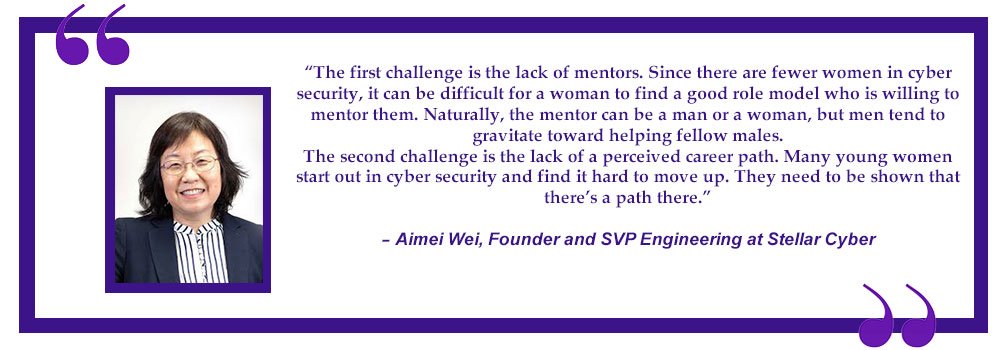Increasing number of unfilled jobs, lack of diverse ideas to secure enterprises is driving organizations to encourage women towards InfoSec careers
Last month, October, was Cyber Security Awareness Month. An important highlight that the InfoSec industry spoke during several of the month-long activities was the immediate need to bring more gender inclusivity in the security tech domain to fill the unprecedented number of roles that are expected to open up. While enough noise is being made globally about making STEM education more accessible to women, and many women are foraying into technology education and taking it up as their career path, many of these women are not considering security tech as their choice. The reason for this being so skewed when it comes to women professionals in cyber security tech than any other tech sector is a lack of awareness, mentors, role models and the belief that it can be a career by itself. To date, women make up only 20% of the cyber security workforce worldwide, not even close to the halfway mark.
Consider this: more than 3.5 million cyber security tech job roles will be left unfilled by 2021. A huge pool of women STEM graduates can be groomed to take these up. Why should they be encouraged? As Dr. Roman V. Yampolskiy of the University of Louisville believes “Cognitive diversity is extremely important in any decision-making process.” And, a diverse cyber security tech workforce will initiate richer ways to secure enterprises and SMBs.
Many leading tech companies have understood this urgent need to bring in gender inclusivity in their cyber security tech teams. However, for the gender gap to reduce it’s critical that enterprises work on the challenges that are veering women towards other tech domains.
Challenges Women Face as Cyber Security Tech Professionals
To understand the challenges women are facing as cyber security tech professionals, who better than women leaders from cyber security companies.


Fighting gender discrimination at all levels whether it is for C-suite executives or for entry-level women professionals, is critical for more tech women professionals entering the cyber security industry. A survey conducted by Veracode and the Center for Cyber Safety and Education revealed that 51% women reported experiencing discrimination on the job, especially among the leadership. If C-level executives are facing discrimination, then the entry-level women security professionals are bound to have it even tougher.
Why is it Important to Reduce the Gender Gap in the Cyber Security Industry?
Humans will always have a bias. However, when companies keep the focus on why it’s critical to bring in gender inclusivity and industry leaders realize the need to explicitly look for the out-of-the-box contenders to take the team’s thinking to an entirely new level, these norms are bound to change.
The same arguments in favor of gender equality in the workplace stand true for the cyber security industry as well – diversity in perspectives, leadership and experience is good for any business including cyber security.
Here’s what Aimei Wei, named in the top 100 women in cyber security has to say:

Sydna Kelly, also named in the top 100 women in cyber security, discusses the unique contributions and perspectives the industry stands to miss out on without a gender-inclusive approach.


How Enterprises are reducing the Gender Gap in the Cyber Security Industry
That there is a strong inherent gender bias in the cyber security tech domain more than for any other technology-oriented roles is evident from the fact that even the search term “cyber security” will throw up images of a man wearing a hoodie hacking into a computer or server. Women’s Society of Cyberjutsu (WSC) is working on changing these prejudices be it in corporate IT security or start-ups and companies with less than 500 employees. Their efforts are ensuring more women are being included in risk, compliance and privacy, and other techie roles, so more young women can be open to pursuing their career in the cyber security field.
With the cyber security market projected to be worth $170 billion, with a shortage of 1.8 million cyber security professionals, positioning women to move into upper-level information security posts is necessary. Employment opportunities in the field of cyber security are expected to increase nearly 20 percent by 2024 according to the US Department of Labor said. Leading tech giants like Google, IBM, and Facebook are driving diversity and inclusion throughout their workforce, and cyber security roles are also being increasingly filled in by women team members due to the realization that diverse teams help better identify and neutralize threats quicker. Cyber security tech companies are also taking initiatives to get more women from STEM to choose security tech as their career paths.
Eva Chen, co-founder and CEO at Trend Micro recently named in the top 100 women in Cyber Security by Cyber Defense magazine has initiated a new partnership with Girls in Tech to help reduce the gender gap in cyber security, and has been vocal in her advocacy of greater diversity within the industry. Also, praiseworthy is the work of the nonprofit Women in Cyber Security (WiCyS) in partnership with Google and SANS, which recently launched their Security Training Scholarship for women.
Interestingly, men in leadership positions too, know the need for bringing in more gender diversity in the cyber security industry. Robb Reck, Chief Information Security Officer at identity security company Ping Identity says, “Anytime you can get diversity, you expand the overall perspective of a group.”

Like mentors needed to guide women in their cyber security careers, women taking up STEM education too should be coached at the university level to think of cyber security tech as a possible technology domain that can be explored. Ensuring young women look at cyber security as a challenging role to fulfill their potential is necessary.
Once they are part of the cyber security, addressing the pay gap and making it commensurate to their male counterparts at the same level, will help shrink the gap and the stigma as well. Allocating budgets to invest in special on-job trainings for women can help them step up their game to ensure equal pay is well-deserved.
Lise Lapointe, author and CEO of Terranova Security, sums the roadmap well, “When I first started in this business, you could count on one hand the number of women you would run into at an industry event. Today, there are security industry events and professional organizations where women are the primary attendees and members. But we still have a long way to go.”

